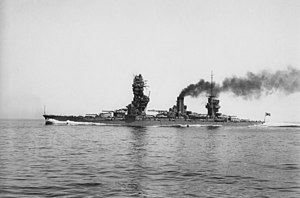Japanese battleship Fusō

Fusō undergoing trials on 10 May 1933 after a major renovation
|
|
| History | |
|---|---|
|
|
|
| Name: | Fusō (Japanese: 扶桑) |
| Namesake: | Classical name for Japan |
| Builder: | Kure Naval Arsenal |
| Laid down: | 11 March 1912 |
| Launched: | 28 March 1914 |
| Commissioned: | 8 November 1915 |
| Struck: | 31 August 1945 |
| Fate: | Sunk during the Battle of Surigao Strait, 25 October 1944 |
| General characteristics (as built) | |
| Class and type: | Fusō-class battleship |
| Displacement: | |
| Length: | |
| Beam: | 28.65 meters (94.0 ft) |
| Draft: | 8.69 meters (28 ft 6 in) |
| Installed power: |
|
| Propulsion: |
|
| Speed: | 23 knots (43 km/h; 26 mph) |
| Range: | 8,000 nmi (15,000 km; 9,200 mi) at 14 knots (26 km/h; 16 mph) |
| Complement: | 1,198 |
| Armament: |
|
| Armor: |
|
| General characteristics (1944) | |
| Displacement: | 34,700 long tons (35,300 t) |
| Length: | 212.75 m (698.0 ft) (o.a.) |
| Beam: | 33.1 m (108 ft 7 in) |
| Draft: | 9.69 m (31 ft 9 in) |
| Installed power: |
|
| Propulsion: | 4 × steam turbines |
| Speed: | 24.5 knots (45.4 km/h; 28.2 mph) |
| Range: | 11,800 nmi (21,900 km; 13,600 mi) at 16 knots (30 km/h; 18 mph) |
| Complement: | approximately 1,900 |
| Sensors and processing systems: |
|
| Armament: |
|
| Armor: | Deck: 152–51 mm (6–2 in) |
| Aircraft carried: | 3 × floatplanes |
| Aviation facilities: | 1 × catapult |
Fusō (扶桑?, a classical name for Japan) was the lead ship of the two Fusō-class dreadnought battleships built for the Imperial Japanese Navy. Launched in 1914 and commissioned in 1915, she initially patrolled off the coast of China, playing no part in World War I. In 1923, she assisted survivors of the Great Kantō earthquake.
Fusō was modernized in 1930–35 and again in 1937–41, with improvements to her armor and machinery and a rebuilt superstructure in the pagoda mast style. With only 14-inch guns, she was outclassed by other Japanese battleships at the beginning of World War II, and played auxiliary roles for most of the war.
Fusō was part of Vice-Admiral Shōji Nishimura's Southern Force at the Battle of Leyte Gulf. She was sunk in the early hours of 25 October 1944 by torpedoes and naval gunfire during the Battle of Surigao Strait. Some reports claimed that Fusō broke in half, and that both halves remained afloat and burning for an hour, but according to survivors' accounts, the ship sank after 40 minutes of flooding. Of the few dozen crewmen who escaped, only 10 survived to return to Japan.
The ship had a length of 192.024 meters (630 ft) between perpendiculars and 202.7 meters (665 ft) overall. She had a beam of 28.7 meters (94 ft 2 in) and a draft of 8.7 meters (29 ft).Fusō displaced 29,326 long tons (29,797 t) at standard load and 35,900 long tons (36,500 t) at full load. Her crew consisted of 1,198 officers and enlisted men in 1915 and 1,396 in 1935. During World War II, the crew probably totalled around 1,800–1,900 men.
...
Wikipedia
